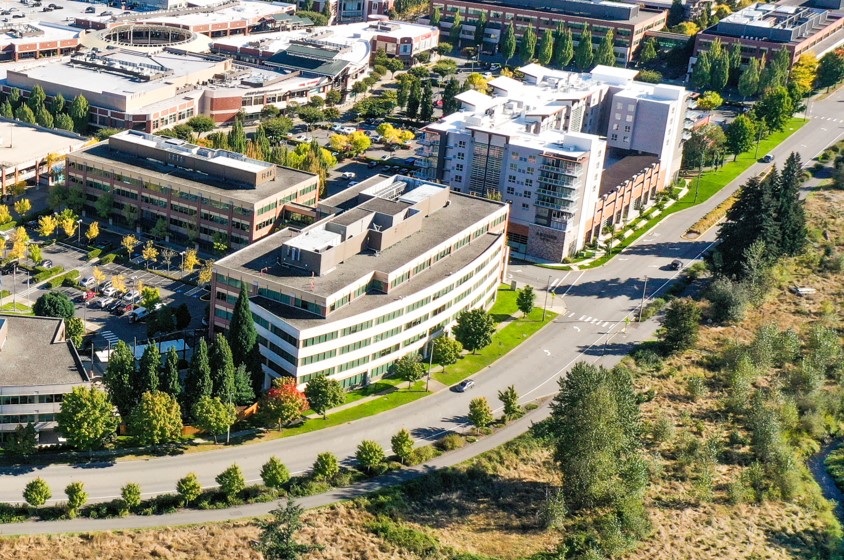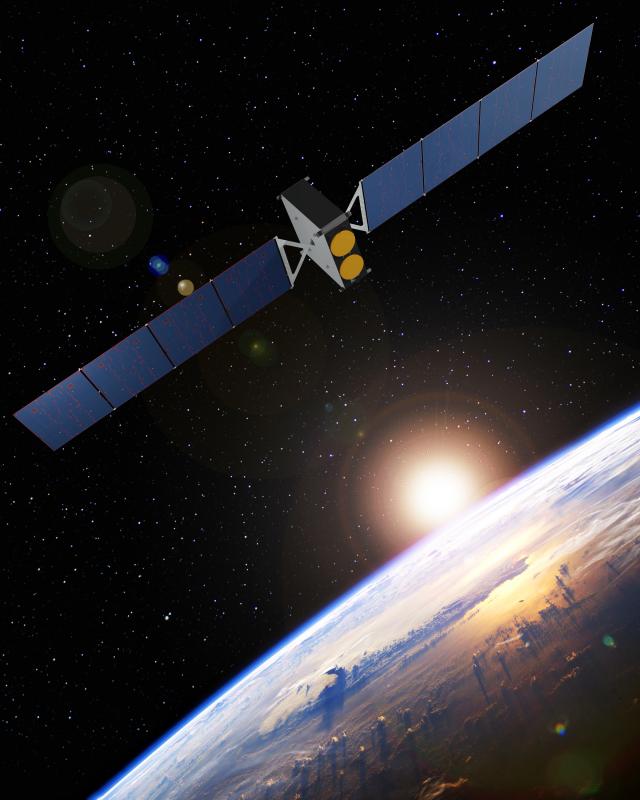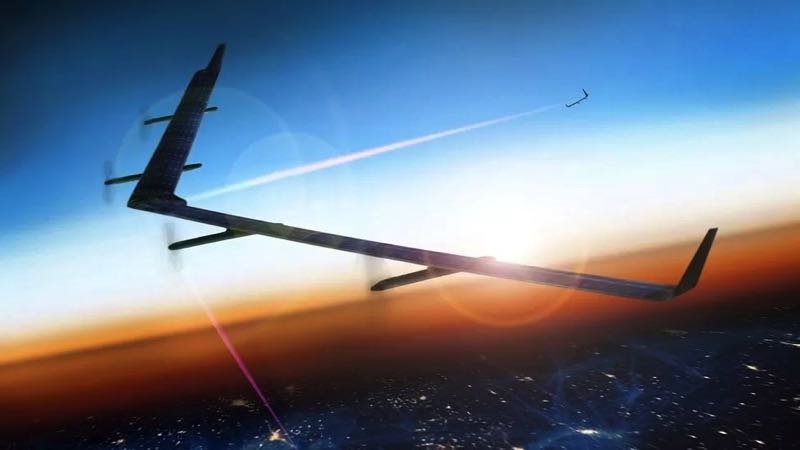 In space, in an area called LEO (Low Earth Orbit) located at a distance of approximately 200 up to 1.000 km above our heads, several hundred, even thousands, satellites are already flying. They are mainly dedicated to communications and observations of all kinds, civil and military.
In space, in an area called LEO (Low Earth Orbit) located at a distance of approximately 200 up to 1.000 km above our heads, several hundred, even thousands, satellites are already flying. They are mainly dedicated to communications and observations of all kinds, civil and military.
But for a short decade a fratricidal war has been declared, a frantic race between several private and semi-public companies to offer high-speed internet to all humans, wherever they live on the globe. The thing is important, because this market, beyond the altruism and generosity displayed by these ambitious programs, promises several billion dollars in earnings in the coming years.
To date, 17 new satellite constellations are being planned, which concern more than 430.000 low orbit satellites (¹). We are talking here about mini-satellites, or nanosatellites, lightweight and easy to launch in packs of several dozen. The way things are going, it is possible to wonder how all this little world will manage to coexist without pile-ups !
The two most advanced actors in this process are Starlink, subsidiaries of SpaceX, both powered by Elon Musk who needs no introduction, and OneWeb, British semi-public airline benefiting from the partnership of Airbus Industrie and a recent alliance with the European telecommunications giant Eutelsat. But other actors are in ambush, tel Amazon by Jeff Bezos or the aeronautics giant Boeing.
The space war
Amazon and SpaceX bosses weigh together more than 380 billion dollars. A colossal fortune largely invested in their space activities. These two companies have the ambition to build gigantic constellations of satellites to connect the whole world to the Internet.
SpaceX received authorization from the American authority, la Federal Communications Commission (FCC), to send 12.000 satellites and ambition, forward, a squadron of 42.000 satellites. Amazon, on his side, obtained FCC approval for a constellation of 3.236 satellites in low Earth orbit via its subsidiary Kuiper Systems, who does not have, to date, no launch yet.
However, SpaceX has filed an application to place its second-generation satellites in a lower-than-planned orbit (from 540 and 570 km instead of 1.100-1.300 km). An altitude that could increase the risk of collision and interfere with Kuiper satellites, programmed themselves to fly at 590 km high. Amazon therefore asked the FCC to stay this request. Amazon thus communicated :
We designed the Kuiper system to avoid interference with Starlink, and SpaceX now wants to change the design of its system. These changes not only create a more dangerous environment for collisions in space, but they also increase radio interference to customers”.
The battle between the two giants only illustrates the growing congestion of space. The development of nanosatellites and the significant drop in the price of launches have caused an unprecedented increase in the number of objects in space in recent years.. After Amazon asks the FCC to reject SpaceX's latest change to its Starlink satellite network, Elon Musk highlighted his company's response that Jeff Bezos is exceptionally litigious. " Lawsuits against SpaceX are actually his full-time job ”, tweeted Elon Musk. Ambiance…!
The most advanced
- STARLINK
 Elon Musk's project is currently the most advanced in reaching the general public. It is also the hugest financially project of the company to build an internet network with a constellation of thousands interconnected satellites., with the aim of providing universal high-speed internet. SpaceX said : " Users can expect to see download speeds between 100 and 200 Mbps and a latency of 20 ms in most places ».
Elon Musk's project is currently the most advanced in reaching the general public. It is also the hugest financially project of the company to build an internet network with a constellation of thousands interconnected satellites., with the aim of providing universal high-speed internet. SpaceX said : " Users can expect to see download speeds between 100 and 200 Mbps and a latency of 20 ms in most places ».
Launched in May 2021, Starlink is already available in the testing phase in 45 countries and claims 700.000 end-users in 2022. Starlink fixed internet is aimed at people living in rural areas or who do not have landline internet options such as ADSL, cable or optical fiber. Starlink also offers a mobile usage plan for vehicles on the move (RV, boating), and a maritime service for maritime professionals. However at the start of the year 2023 the system is still in the testing phase, services and tariffs are not yet clearly defined, and coverage far from global.
Mid-February 2023, SpaceX has already put into orbit 3.415 satellites and aims for a total of 4.408 satellites for the first generation SG1 program. A second SG2 program has been approved by the FCC for 7.500 satellites, dont 269 already in orbit, which should be completed by 22.488 additional satellites, awaiting approval. The company detailed plans for the next generation of satellites in federal filings. According to it, " the satellites of the SG2 program are heavier and will be a little larger and will generate more power than the previous ones. The SG2 constellation will complement the first generation constellation currently deployed”, wrote SpaceX during the filing. The complete constellation, with almost 34.400 planned satellites, will form the infrastructure that will allow Elon Musk to deliver high-speed internet and unlimited data to remote areas around the world.
- ONEWEB
 The British company OneWeb, with which Eutelsat, third largest telecom satellite operator in the world, announced the merger, will provide global high-speed Internet access, mainly for professional users. The European space giant Airbus industry delivered within four years 544 satellites on the 648 planned for the first generation OW1. The first models, about ten units, had been manufactured in Toulouse and the remainder was then mass-produced in a factory in Florida owned by OneWeb Satellites, joint venture equally between OneWeb and Airbus Defence and Space.
The British company OneWeb, with which Eutelsat, third largest telecom satellite operator in the world, announced the merger, will provide global high-speed Internet access, mainly for professional users. The European space giant Airbus industry delivered within four years 544 satellites on the 648 planned for the first generation OW1. The first models, about ten units, had been manufactured in Toulouse and the remainder was then mass-produced in a factory in Florida owned by OneWeb Satellites, joint venture equally between OneWeb and Airbus Defence and Space.
With the latest launch of 48 new satellites on 10 January 2023, next to 85% of the constellation is now in orbit, bringing the number of operational satellites to 544. OneWeb had also requested 2018 authorization for the FCC to deploy 1.260 additional satellites, which will increase the total number of the project to 1.980 satellites.
From the start 2023, The constellation is to provide high-speed, low-latency connectivity to a wide range of civil and military sectors, especially aviation, Navy, business and government. At the heart of its objective, OneWeb seeks to bring connectivity to places inaccessible to fiber optics, and thus bridge the digital divide, in direct competition with Starlink. This did not prevent the last satellites from being launched by SpaceX Falcon 9 rockets in 2023. Business is business !
Latecomers
- KUIPER
Amazon announced in 2019 its satellite internet project called Kuiper. Company revealed plans and launch provider for prototype satellites. The infrastructure would include very low-cost receiving dishes 30 cm wide, coming from ReQuTech in Sweden, can support up to 400 Mbps Data Rate. Jeff Bezos plans to launch 3.236 satellites internet en LEO, a system directly competing with Starlink.
Amazon said it plans to invest more than 10 billion dollars in the construction of the Kuiper project, and it already has a research and development facility of 20.000 square meters in Redmond, in Washington State. The Redmond site developed prototypes and assisted in the production of commercial satellites, “but to realize our vision of the project, we need to operate on a much larger scale.", said Amazon. A new factory in the suburbs of Seattle, in Kirkland, is being built to support the manufacturing of its own Project Kuiper satellites.

Tech giant adds space in Redmond (WA) for its Project Kuiper operation and invests in Kirkland near Seattle.
Although Amazon has taken a first step toward hardware for the antennas it needs to connect to the network, it has not yet started launching its satellites. The first two prototypes should be launched at the start of the year 2023. In a press release, Amazon explained : “We will use the results of the mission to finalize the design, the deployment and operational plans of our commercial satellite system ».
It seems clear that Bezos has fallen behind Starlink, and he loses the best places in the firmament ! It must therefore slow down the forced march of its competitor to maintain available space.. Bezos' company asks FCC to reject SpaceX's SG2 amendment request, claiming it violates FCC rules by offering two different configurations in orbit. Lawyer for Amazon's Kuiper Company, wrote the 25 August 2022 :
Leaving almost every important detail unresolved – such as altitude, the inclination, and even the total number of satellites – SpaceX failed to comply with FCC rules ».
Orbiting objects will have to play hard to get a place around the Earth !
- BOEING
 The US aeronautics leader Boeing also obtained in November 2021 green light from the US authorities for its constellation project with a first batch of 147 satellites, intended to provide internet from space. The vast majority of satellites must orbit in the lower part of the LEO at 156 km high (²) and 15 other much higher, in MEO (³) between approximately 27.000 and 44.000 km. The long-term project concerns a constellation of 5.841 satellites to cover the entire planet.
The US aeronautics leader Boeing also obtained in November 2021 green light from the US authorities for its constellation project with a first batch of 147 satellites, intended to provide internet from space. The vast majority of satellites must orbit in the lower part of the LEO at 156 km high (²) and 15 other much higher, in MEO (³) between approximately 27.000 and 44.000 km. The long-term project concerns a constellation of 5.841 satellites to cover the entire planet.
The company plans to offer high-speed internet connection services, priority to rural Americans affected by the digital divide, but also in regions where it is impossible to access fixed telecommunications networks. The group estimated that it would take six years to deploy a first part of its space infrastructure and open its first services., and as many additional years to have a complete constellation covering most of the globe.
It should be remembered that Boeing is a major manufacturer of satellites for large operators like Inmarsat, SES, Intelsat, Eutelsat, VSAT, and many others. Despite the hazards of civil aeronautics, the company has undeniable know-how and financial capacity.
The failures
- GOOGLE LOON
Google X considers itself a “factory of revolutionary ideas”. On his website, we could read :
Our mission is to invent and launch cutting-edge technologies that, we hope so, can one day make the world radically better”.
One of their most notable projects was the project Loon. Rather than opting for a constellation of satellites, expensive, complex to coordinate and requiring a large specialized infrastructure, Google X aimed lower. The company planned to install a series of solar-powered hot air balloons in the upper atmosphere, at the edge of space.
The goal was to provide internet access to the world's poorest, the most untapped market for internet consumers. But opening new markets could have real benefits, such as providing cell phone services and internet access to aid workers and residents in disaster areas until local sources are available again.
Alas, the parent company of Google, Alphabet, definitively stopped its Loon program in January 2021. The company realized that the operation was economically too uncertain. More than seven years after presenting this extravagant project, the American company understood that it was going nowhere. In a post on his blog published on 22 January 2021, it was therefore decided to stop the shooting. End of story.
- FACEBOOK AND ITS DRONES
Facebook planned to launch a fleet of solar-powered drones, in order to transmit Wi-Fi to Internet-deprived populations. Each drone had to cover an area of 100 km in diameter and fly at an altitude greater than 18.200 meters. Le premier prototype, The’Aquila, a giant wing of 30 m span, weighed 454 kg.
According to the social media giant, the drone would transmit Wi-Fi signals by means of “laser communications and millimeter wave systems”. Each drone could fly for three months straight. “In addition to being at the cutting edge of technology, it would be energy efficient, absorbing the 5.000 watts it needs thanks to the sun. That's not a lot of energy, the equivalent of what is needed to run three hair dryers or a high-end microwave”.
Although it may have seemed like a solid project, the second test flight in February 2018 did not go well. The drone reached 3.000 feet (910 meters). But he only held 96 minutes before crashing to the ground. This was three times the duration of the first test flight, which took place in December 2017. Despite this, in a blog post in 2018, Facebook says it will no longer design or build its own planes and close its Bridgewater facility.
And then ?
At the beginning of this year that has seen many sailors around the globe rush to Starlink dishes and services, with mostly rave reviews despite a product that is not really suitable and a service that has not been finalized, the future now seems set… in the stars ! To paraphrase what I wrote in my recent Guide Expert at Voiles & Voiliers :
[…] it is certain that access to weather forecasts and navigation safety information will become, in a few years, as easy at sea as on land. ”
Is it a safe bet that we will spend more time at sea with our noses glued to a screen than contemplating the waves?, clouds, the birds, dolphins, sunrises and sunsets… ? It's another story. In any case we will inevitably have our eyes in the stars.
–––
(¹) All figures come from Jonathan McDowell's excellent and exhaustive observatory Jonathan’s Space Report.
(²) For the record, the International Space Station (ISS) orbits at an average altitude of 400 km.
(³) MEO : Medium Earth Orbit. Region used by most positioning constellations (see GNSS in the Glossary).
–––



Thank you Francis for this technological watch. It is certain that we will find it increasingly easier to have reliable weather at sea., far from the coast. However, we must not forget the interest of AIS which will also allow the exchange of data for nearby boats.. Coming across a cargo ship could be synonymous with weather full of fresh grib !
Thank you once again for this detailed article.. It remains to be seen when the average navigator that I am will be able to take this step towards the stars